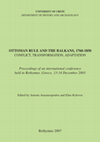Papers by Gergana Georgieva
Proceedings of the Centre for Economic History Research, 2018
Proceedings of the Centre for Economic History Research, 2019
Encyclopaedia of Islam, THREE

In the late 18th century the Ottoman Empire almost completely lost control of its import and expo... more In the late 18th century the Ottoman Empire almost completely lost control of its import and export trade, which were run mainly by foreign merchants. Therefore, a large part of Ottoman traders accepted the status of proteges of those mustemins and became foreign citizens. In early 19th century the Ottoman authorities took some steps in order to restore the balance. They created two special categories of Ottoman merchants – avrupa tuccars (non-Muslims) and hayriye tuccars (Muslims), also known as beratlis, because of the special certificate (berat) they received from the authorities. The beratlis had the right to trade on the international market and to organize the international trade of the Empire. Beratlis were distinguished by a number of privileges they received from the Ottoman authorities, by the considerable capital they possessed, and by the networks of contacts and connections in the Ottoman Empire and abroad that they built. The article presents the category of non-Muslim...
Southeast European and Black Sea Studies, 2018
Etudes balkaniques, 2003
... by Gergana Georgieva Source: Balkan Studies (Etudes balkaniques), issue: 2 / 2003, pages: 577... more ... by Gergana Georgieva Source: Balkan Studies (Etudes balkaniques), issue: 2 / 2003, pages: 5777, on www.ceeol.com. ... Gergana GEORGIEVA (Institute of Balkan Studies) FUNCTIONS AND PREROGATIVES OF THE RUMELI VALI IN THE FIRST HALF OF THE 19th CENTURY ...
The article presents new information on the socio-economic development of Svishtov in the 19th c.... more The article presents new information on the socio-economic development of Svishtov in the 19th c. extracted from unpublished Ottoman documents. In the 19th c. Svishtov developed as one of the main Danubian harbors in the Lower Danube which played crucial role in trade relations between Bulgarian lands, Wallachia and Central Europe. It is characterized by intensive economic progress, based mainly on trade and production of clothes and shoes. The new primary sources reveal details about its socio-economic structure. There was a high level of specialization of merchants – salt trade was one of its basic characteristics. It is also evident the predominance of the small scale merchandise. The land transport was as well presented as water transport. The relatively well-developed economy of Svishtov is presented also by the high annual income declared by the taxpayers.
... За центъра на провинция Румелия (от края на XVIII век до 1839 г.) «The Centre of Rumeli Provi... more ... За центъра на провинция Румелия (от края на XVIII век до 1839 г.) «The Centre of Rumeli Province (from the end of the 18th century to 1839)» by Gergana Georgieva Source: Historical future (Историческо бъдеще), issue: 12 / 2004, pages: 4770, on www.ceeol.com. Page 2. ...

The Ottoman period is a legacy with which Bulgarians have to deal. It contributes considerably to... more The Ottoman period is a legacy with which Bulgarians have to deal. It contributes considerably to how the others perceive Bulgarians (and the Balkan region as a whole), and how Bulgarians/Balkans observe themselves. Interpreting this period as part of the large narrative of the national Bulgarian history, the Ottoman rule is defined in Bulgaria as the period of suffering. Therefore, the analysis of attitudes towards the Ottoman Empire and the Ottomans helps clarify the process of creating positive/negative perceptions about historical events from a national perspective, and also helps deal with an issue which is important for every national historiography: the creation of the notion of the Other. The main aim of this chapter is to investigate the usage and interpretation of the Ottoman legacy as part of the national Bulgarian ideology and to shed light on some techniques of manipulation and creation of stereotypes based on texts that deal with the Ottoman past. Hence, the chapter fa...

The Ottoman Rule and the Balkans, 1760-1850: Conflict, Transformation, Adoption. Rethymno: Crete University Press, 2007
The aim of the conference was to investigate various aspects of the process of de-legitimisation ... more The aim of the conference was to investigate various aspects of the process of de-legitimisation of Ottoman rule in the Balkans in the late eighteenth and early nineteenth centuries up to and including the Greek Revolution of 1821. Thus, in the volume which resulted from the conference, particular emphasis has been placed on two interrelated themes which share the examination of conditions in the Balkan provinces of the Ottoman Empire as their background. The first theme has two aspects: one is agents, instances and acts of defiance or weakening of the Ottoman central control, and the other is the disaffection of provincial societies and their elites with Istanbul and its representatives. In this context, it is interesting to note that such phenomena were not single-handedly identified with particular religious or ethnic groups; on the other hand, it is also important to consider what the nature, extent, and implications of disaffection were, and, more specifically, if there was widespread discontent with Ottoman rule at the popular level and, if yes, of what kind, or if this was restricted to elite groups as part of power games which in the short term did not challenge Ottoman authority as such, but aimed at increasing one's personal and family power and wealth. The second theme is the emergence of aspirations for secession from the Ottoman Empire and formation of nation-states among the peoples of the Balkan peninsula, and their impact on the region. The Greek Revolution 1 is often highlighted as the culmination of this aspect of de-1 We refrained from imposing one single term for what is by different authors in this volume called the 'Greek Revolution of 1821', the 'Greek War of Independence', the 'Greek Revolt', or the 'Greek Rebellion', as we believe that the terms as such are indicative of the various interpretations and ideological/methodological stances towards this event. For a discussion of terms, see Christine Philliou's paper in this volume. * The conference and the publication of its proceedings were made possible through grants received from the Alexander S. Onassis Public Benefit Foundation, Alpha Bank, Emporiki Bank, the J. F. Costopoulos Foundation, and Piraeus Bank. We gratefully acknowledge their support. The Department of History and Archaeology of the University of Crete, as the organiser, also met a considerable part of the cost of the conference. We would also like to extend our thanks to Christos Loukos (whose idea the conference was) and Socrates Petmezas, members of the organising committee, as well as to all those, associates and students, who were involved in the conference and the preparation of this volume, especially Eleni Perraki, who provided secretarial services, and Yorghos Vidras; Alexandria Publications (Athens) for their kind assistance with publishing this volume; Athena Skoulariki for her help with editing the papers in French; and Geoffrey Cox for his conscientious English language editing and his patience.
Известия на Регионален исторически музей - Габрово, 2016
Известия на Центъра за стопанско-исторически изследвания, 2018
The article presents the social and economic development of the
village of Tryavna in the middle ... more The article presents the social and economic development of the
village of Tryavna in the middle of the 19th c. and the place of Tryavna’s chorbadzhis
in the local economic development. The study aims to draw attention to the profile of
the chorbadzhis and their economic abilities, while simultaneously comparing them to
the financial and property status of other villagers. Sources of various origins and
characteristics have been used in the analysis. They were created by the Ottoman
authorities or by the local Bulgarian municipality. This allows fuller and more
accurate representation of the object of study.
Key words: Tryavna, mountainous economy, local elite, chorbadzhis, temettuat
defters
Abstract: The theme of the early industrialization of the Ottoman Empire, particularly of the Bal... more Abstract: The theme of the early industrialization of the Ottoman Empire, particularly of the Balkans and the Bulgarian lands as part of the Empire until 1878, is still incompletely explored. The problem is not only the lack of reliable historical sources, but also the random and often incorrect use of economic concepts, which is leading to inaccurate interpretation of the available information. The purpose of this study is to clarify through reliance on the sources and historiographical analysis which and how many companies classified as factories existed in the Bulgarian lands until the Liberation (1878).
Key words: factory, the Bulgarian lands, the Ottoman Empire, industrialization











Uploads
Papers by Gergana Georgieva
village of Tryavna in the middle of the 19th c. and the place of Tryavna’s chorbadzhis
in the local economic development. The study aims to draw attention to the profile of
the chorbadzhis and their economic abilities, while simultaneously comparing them to
the financial and property status of other villagers. Sources of various origins and
characteristics have been used in the analysis. They were created by the Ottoman
authorities or by the local Bulgarian municipality. This allows fuller and more
accurate representation of the object of study.
Key words: Tryavna, mountainous economy, local elite, chorbadzhis, temettuat
defters
Key words: factory, the Bulgarian lands, the Ottoman Empire, industrialization
village of Tryavna in the middle of the 19th c. and the place of Tryavna’s chorbadzhis
in the local economic development. The study aims to draw attention to the profile of
the chorbadzhis and their economic abilities, while simultaneously comparing them to
the financial and property status of other villagers. Sources of various origins and
characteristics have been used in the analysis. They were created by the Ottoman
authorities or by the local Bulgarian municipality. This allows fuller and more
accurate representation of the object of study.
Key words: Tryavna, mountainous economy, local elite, chorbadzhis, temettuat
defters
Key words: factory, the Bulgarian lands, the Ottoman Empire, industrialization